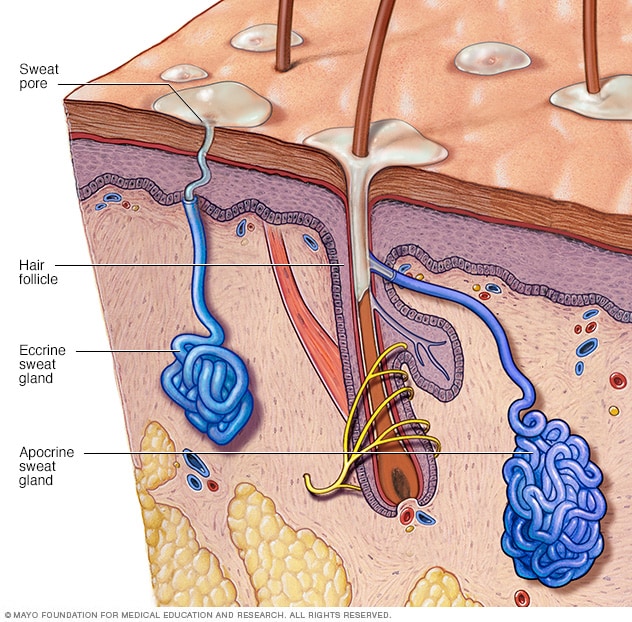Hyperhidrosis
Hyperhidrosis
overview
Hyperhidrosis (hi-pur-hi-DROE-sis) is unusually excessive sweating that is not necessarily related to heat or exercise. You may sweat so much that it seeps through your clothes or drips off your hands. This type of heavy sweating can not only disrupt normal daily activities but can also cause social anxiety and embarrassment.
Treating hyperhidrosis usually helps, starting with prescription antiperspirants. If antiperspirants don't help, you may need to try other medications and therapies. In severe cases, your doctor may suggest surgery to either remove the sweat glands or disconnect the nerves responsible for excessive sweat production.
Sometimes an underlying cause can be found and treated.
Symptoms
Most people sweat when they exercise or exert themselves, are in a hot environment, or are anxious or stressed. The excessive sweating in hyperhidrosis goes far beyond normal sweating.
The type of hyperhidrosis, which usually affects the hands, feet, armpits or face, causes at least one episode per week during waking hours. And sweating usually occurs on both sides of the body.
When to go to the doctor?
Sometimes excessive sweating is a sign of a serious illness.
See a doctor immediatelyif your heavy sweating is accompanied by dizziness, chest pain or nausea.
See your doctor if:
- Schwitzen stört Ihren Tagesablauf
- Schwitzen verursacht emotionalen Stress oder sozialen Rückzug
- Sie fangen plötzlich an, mehr als sonst zu schwitzen
- Sie leiden ohne ersichtlichen Grund unter Nachtschweiß
Causes
Sweat glands

Sweat glands
Your skin has two types of sweat glands: eccrine and apocrine. Eccrine glands occur throughout most of your body and open directly on the surface of the skin. Apocrine glands open into the hair follicle and lead to the surface of the skin. Apocrine glands develop in areas rich in hair follicles, such as: B. on the scalp, armpits and groin area.
Sweating is your body's mechanism for cooling itself down. Your nervous system automatically activates your sweat glands when your body temperature rises. Sweating also usually occurs, especially on your palms, when you are nervous.
The most common form of hyperhidrosis is called primary focal (essential) hyperhidrosis. In this type, the nerves responsible for signaling your sweat glands become overactive, even though they haven't been triggered by physical activity or a rise in temperature. When you are stressed or nervous, the problem becomes even worse. This type usually affects your palms and soles and sometimes your face.
There is no medical cause for this type of hyperhidrosis. It may have a hereditary component as it sometimes runs in families.
Secondary hyperhidrosis occurs when excessive sweating is due to a medical condition. It's the rarer kind. You're more likely to sweat all over your body. Conditions that can cause heavy sweating include:
- Diabetes
- Hitzewallungen in den Wechseljahren
- Schilddrüsenprobleme
- Niedriger Blutzucker
- Einige Krebsarten
- Herzinfarkt
- Erkrankungen des Nervensystems
- Infektionen
Certain medications can also cause excessive sweating, as can opioid withdrawal.
Complications
Complications of hyperhidrosis include:
- Infektionen. Menschen, die stark schwitzen, sind anfälliger für Hautinfektionen.
- Soziale und emotionale Auswirkungen. Feuchte oder tropfende Hände und schweißgetränkte Kleidung können peinlich sein. Ihr Zustand kann Ihre beruflichen und schulischen Ziele beeinträchtigen.
Treatment of hyperhidrosis
Sources:
- Fragen Sie MayoExpert. Hyperhidrose (Erwachsene und Kinder). Rochester, Minnesota: Mayo Foundation for Medical Education and Research; 2017.
- Hyperhidrose. Merck Manual Professional-Version. https://www.merckmanuals.com/professional/dermatologic-disorders/sweating-disorders/hyperhidrosis. Abgerufen am 18. August 2017.
- Smith CC, et al. Primäre fokale Hyperhidrose. https://www.uptodate.com/content/search. Abgerufen am 18. August 2017.
- Was ist ein Herzinfarkt? Nationales Institut für Herz, Lunge und Blut. http://www.nhlbi.nih.gov/health/health-topics/topics/heartattack. Abgerufen am 18. August 2017.
- Eisenach JH, et al. Hyperhidrose: Entwicklung von Therapien für ein etabliertes Phänomen. Verfahren der Mayo-Klinik. 2005;80:657.
- Barbara Woodward Lips Patientenschulungszentrum. Hyperhidrose (übermäßiges Schwitzen). Rochester, Minnesota: Mayo Foundation for Medical Education and Research; 2010.
- Riggin EA. System zur Entscheidungsfindung. Mayo Clinic, Rochester, Minnesota, 21. August 2017.
- Hines RL, et al. Erkrankungen des vegetativen und peripheren Nervensystems. In: Stöltings Anästhesie und Begleiterkrankungen. 7. Aufl. Philadelphia, Pennsylvania: Elsevier; 2018.
- Stashak Ab, et al. Behandlung von Hyperhidrose. Klinische, kosmetische und Prüfdermatologie. 2014;7:285.
- Gibson LE (Gutachten). Mayo Clinic, Rochester, Minnesota, 20. September 2017.

 Suche
Suche
 Mein Konto
Mein Konto